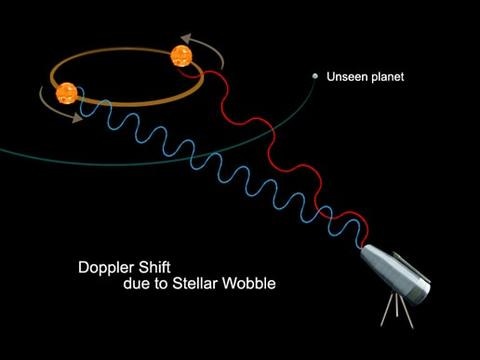May 27 2019
Astronomers consider that planets such as Jupiter protect humans on the Earth from space objects that would otherwise smash into Earth. At present, they are one step closer to understanding whether giant planets function as guardians of other solar systems in other parts of the galaxy.
 The “wobble” technique: blue wave shows movement toward Earth and the red occurs as the star heads away. (Image credit: NASA/JPL-Caltech)
The “wobble” technique: blue wave shows movement toward Earth and the red occurs as the star heads away. (Image credit: NASA/JPL-Caltech)
A team of researchers led by UCR has identified two Jupiter-sized planets located nearly 150 light-years away from Earth that could reveal whether life is possible on the smaller planets in other solar systems.
We believe planets like Jupiter have profoundly impacted the progression of life on Earth. Without them, humans might not be here to have this conversation. Understanding how many other stars have planets like Jupiter could be very important for learning about the habitability of planets in those systems.
Stephen Kane, Associate Professor of Planetary Astrophysics, University of California, Riverside
Kane is the lead author of the study. According to him, together with liquid water oceans, astronomers are of the view that such planets have the potential to act as “slingshots,” pulling objects such as comets, meteors, and asteroids out of their trajectories on their way to strike small, rocky planets.
A number of larger planets have been discovered close to their stars. But those are not so helpful for understanding about the framework of our own solar system, in which the giant planets such as Saturn, Uranus, and Neptune are all located very far from the sun. To date, huge planets located far away from their stars have been challenging to find.
A study reported recently in the Astronomical Journal described how Kane and his colleagues were successful in an innovative strategy that combines conventional detection methods with the most advanced technologies.
One famous technique of looking for exoplanets—planets that belong to other solar systems—involves monitoring stars for “wobble,” wherein a star moves toward and away from Earth. The wobble is possibly brought about by the gravitational pull exerted on it by a nearby planet. If a star wobbles, it is a hint that there could be an exoplanet closeby.
If the planet is located far away from its star, the gravitational pull is relatively weak, rendering the wobble smaller and more challenging to detect. According to Kane, one more issue with using the wobble detection technique is that it requires a longer time. Earth orbits the sun in just a year, Jupiter in 12 years, Saturn in 30 years, and Neptune takes an overwhelming 164 years.
The larger exoplanets also take several years to orbit their stars, indicating that to observe a complete orbit, an astronomer’s entire career would be needed. In order to speed up the process, Kane and his colleagues combined the wobble technique with direct imaging. As a result, if they doubted whether a planet might be causing wobble, they could confirm it through observations.
It is not simple to acquire a direct image of a planet located quadrillions of miles away. The largest possible telescope would be required, one that is highly sensitive and has a length of at least 32 feet. Even from such a distance, the image could be overexposed by the light of the stars, thereby masking the target planets.
The team solved this problem by learning to identify and remove the patterns in their images formed by starlight. Eliminating the starlight enabled the researchers to see what was left out.
Direct imaging has come a long way both in terms of understanding the patterns we find, and in terms of the instruments used to create the images, which are much higher resolution than they’ve ever been. You see this every time a new smartphone is released—the camera detectors are always being improved and that’s true in astronomy as well.
Stephen Kane, Associate Professor of Planetary Astrophysics, University of California, Riverside
In this study, the researchers used the combination of wobble and imaging technique for 20 stars. Apart from the two being circled by giant Jupiter-like planets that had not been detected earlier, the researchers also discovered a third star that was observed earlier with a giant planet in its system.
In the future, the researchers will continue to observe 10 of the stars in which planetary companions could not be ruled out. Moreover, Kane is planning a new study to evaluate the time taken by these exoplanets to complete rotations toward and away from their stars, which cannot be evaluated at present.
Kane’s group is international, including members at the Australian Astronomical Observatory, University of Southern Queensland, University of New South Wales, and Macquarie University in Australia, as well as at the University of Hertfordshire in the United Kingdom. They are also spread across the United States at the National Optical Astronomy Observatory in Tucson, AZ, Southern Connecticut State University, NASA Ames Research Center and Stanford University in California, and the Carnegie Institution of Washington in D.C.
This discovery is an important piece of the puzzle because it helps us understand the factors that make a planet habitable and whether that’s common or not. We are converging rapidly on answers to this question that the past 3,000 recorded years of history could only wish they had available to them.
Stephen Kane, Associate Professor of Planetary Astrophysics, University of California, Riverside